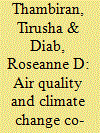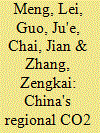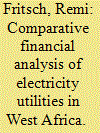|
|
|
Sort Order |
|
|
|
Items / Page
|
|
|
|
|
|
|
| Srl | Item |
| 1 |
ID:
109708


|
|
|
|
|
| Publication |
2011.
|
| Summary/Abstract |
In this paper we describe how behavioral responses of carbon dioxide (CO2) tax increases are accounted for in tax revenue estimation in Sweden. The rationale for developing a method for this is a mix between that a CO2 tax is a primary climate policy tool aiming to reduce CO2 emissions and that the CO2 tax generates sizable tax revenues.
|
|
|
|
|
|
|
|
|
|
|
|
|
|
|
|
| 2 |
ID:
109706


|
|
|
|
|
| Publication |
2011.
|
| Summary/Abstract |
Industries in Durban, South Africa, are a major source of air pollutant emissions and large users of fossil fuel based energy. Durban's energy strategy prioritises energy efficiency at industries as a key action, whilst industries are also the focus of the city's air quality management plan (AQMP). In this paper, measures that have been introduced in industries in Durban to effect air quality improvements and reduce energy consumption are examined in terms of their respective impacts on greenhouse gas (GHG) and air pollutant emissions. It was found that co-benefits for GHG mitigation were achieved when petroleum refineries switched from using heavy fuel oil to refinery gas and methane rich gas. Within other industries, co-benefits for air quality stemmed from reducing fossil fuel energy consumption and the improved efficiency of combustion systems. Air quality and energy policies in the city are being executed independently, without consideration of the trade-offs or synergies of the interventions being implemented. Recommendations are made for authorities and industries to consider the co-benefits for GHG mitigation in their AQMPs and where these are not possible to consider offsetting the increased GHG emissions through improved alignment with energy strategies.
|
|
|
|
|
|
|
|
|
|
|
|
|
|
|
|
| 3 |
ID:
109711


|
|
|
|
|
| Publication |
2011.
|
| Summary/Abstract |
This article presents the main regulatory changes that occurred in the Brazilian power sector in 2009, along with the impacts these changes caused on the market, especially related to small hydropower (<30 MW). This study addresses regulatory issues based on inventory studies and records of basic projects, changes related to the compensation of the assured energy of SHPs in the Brazilian energy reallocation market, the socio-economic impact resulting from the construction of SHPs, SHPs in alternative resource auctions and finally the general outlook for the growth scenario for SHPs in Brazil according to the ten-year plan (2010-2019). The overall conclusions of this investigation were that the 2008/2009 biennium was a period of great changes in the regulation of small hydropower plants in Brazil, and the SHP market has shown maturity. Additionally, despite SHP being a type of technology that is completely dominated by domestic industry, in recent years, they have experienced policy disincentives caused by changes to rules that inhibit their growth.
|
|
|
|
|
|
|
|
|
|
|
|
|
|
|
|
| 4 |
ID:
109623


|
|
|
|
|
| Publication |
2011.
|
| Summary/Abstract |
The energy industry, accounts for the largest portion of CO2 emissions, is facing the issue of compliance with the national clean energy policy. The methodology for evaluating the energy mix policy is crucial because of the characteristics of lead time embedded with the power generation facilities investment and the uncertainty of future electricity demand. In this paper, a modified binomial model based on sequential compound options, which may account for the lead time and uncertainty as a whole is established, and a numerical example on evaluating the optional strategies and the strategic value of the cleaner energy policy is also presented. It is found that the optimal decision at some nodes in the binomial tree is path dependent, which is different from the standard sequential compound option model with lead time or time lag concept. The proposed modified binomial sequential compound real options model can be generalized and extensively applied to solve the general decision problems that deal with the long lead time of many government policies as well as capital intensive investments.
|
|
|
|
|
|
|
|
|
|
|
|
|
|
|
|
| 5 |
ID:
109606


|
|
|
|
|
| Publication |
2011.
|
| Summary/Abstract |
The growing interest in biofuels has led to increasing concern about their wider implications, particularly if grown for transport use in large scale. Such concerns include environmental, social and economic issues. To counterbalance the possible negative effects, a series of measures are being put in place to help their sustainability. Nevertheless, considering the different meanings of sustainability in different parts of the world and the need to expand productive rural activities, the differences between trying to assure a commodity and the benefits or impacts at local level raise the questions between the aims of sustainability and the need to comply with a market. The ideal situation would be to reconcile both aspects, which in practise represent a major challenge for governments and industry. This paper provides an overview on the sustainability assessment of biofuels to consider a possible way forward.
|
|
|
|
|
|
|
|
|
|
|
|
|
|
|
|
| 6 |
ID:
109608


|
|
|
|
|
| Publication |
2011.
|
| Summary/Abstract |
Energy consumption by building sector becomes more and more important in a rapid growing economy like China. Tremendous efforts have been made on building energy conservation (BEC) to comply with the national energy-saving policies over the last three decades. At the same time, with the increasing awareness of the importance of indoor air quality (IAQ), Ministry of Health (MoH) also initiates the related standards to fulfill the needs. BEC and IAQ are two main concerns in the current building management practice. This paper makes an attempt, based on the regulations and standards in chronological order, to elaborate the followings: (1) the development history of BEC and IAQ management in civil buildings in China, (2) the interplay and sometimes seeming conflicts of BEC and IAQ management in the real practice, (3) the importance of proper communications between related authorities in setting up cross-linked regulations to ensure the success of better building managements.
|
|
|
|
|
|
|
|
|
|
|
|
|
|
|
|
| 7 |
ID:
109617


|
|
|
|
|
| Publication |
2011.
|
| Summary/Abstract |
The battery size of a Plug-in Hybrid Electric Vehicle (PHEV) is decisive for the electrical range of the vehicle and crucial for the cost-effectiveness of this particular vehicle concept. Based on the energy consumption of a conventional reference car and a PHEV, we introduce a comprehensive total cost of ownership model for the average car user in Germany for both vehicle types. The model takes into account the purchase price, fixed annual costs and variable operating costs. The amortization time of a PHEV also depends on the recharging strategy (once a day, once a night, after each trip), the battery size, and the battery costs. We find that PHEVs with a 4 kWh battery and at current lithium-ion battery prices reach the break-even point after about 6 years (5 years when using the lower night-time electricity tariffs). With higher battery capacities the amortization time becomes significantly longer. Even for the small battery size and assuming the EU-15 electricity mix, a PHEV is found to emit only around 60% of the CO2 emissions of a comparable conventional car. Thus, with the PHEV concept a cost-effective introduction of electric mobility and reduction of greenhouse gas emissions per vehicle can be reached.
|
|
|
|
|
|
|
|
|
|
|
|
|
|
|
|
| 8 |
ID:
109603


|
|
|
|
|
| Publication |
2011.
|
| Summary/Abstract |
There is a large interest in biofuels in India as a substitute to petroleum-based fuels, with a purpose of enhancing energy security and promoting rural development. India has announced an ambitious target of substituting 20% of fossil fuel consumption by biodiesel and bioethanol by 2017. India has announced a national biofuel policy and launched a large program to promote biofuel production, particularly on wastelands: its implications need to be studied intensively considering the fact that India is a large developing country with high population density and large rural population depending upon land for their livelihood. Another factor is that Indian economy is experiencing high growth rate, which may lead to enhanced demand for food, livestock products, timber, paper, etc., with implications for land use. Studies have shown that area under agriculture and forest has nearly stabilized over the past 2-3 decades. This paper presents an assessment of the implications of projected large-scale biofuel production on land available for food production, water, biodiversity, rural development and GHG emissions. The assessment will be largely focused on first generation biofuel crops, since the Indian program is currently dominated by these crops. Technological and policy options required for promoting sustainable biofuel production will be discussed.
|
|
|
|
|
|
|
|
|
|
|
|
|
|
|
|
| 9 |
ID:
109642


|
|
|
|
|
| Publication |
2011.
|
| Summary/Abstract |
In this study, electricity generation associated CO2 emissions and fuel-specific CO2 emission factors are calculated based on the IPCC methodology using the data of fossil-fueled power plants that ran between 2001 and 2008 in Turkey. The estimated CO2 emissions from fossil-fueled power plants between 2009 and 2019 are also calculated using the fuel-specific CO2 emission factors and data on the projected generation capacity of the power plants that are planned to be built during this period. Given that the total electricity supply (planned+existing) will not be sufficient to provide the estimated demand between 2011 and 2019, four scenarios based on using different fuel mixtures are developed to overcome this deficiency. The results from these scenarios show that a significant decrease in the amount of CO2 emissions from electricity generation can be achieved if the share of the fossil-fueled power plants is lowered. The Renewable Energy Scenario is found to result in the lowest CO2 emissions between 2009 and 2019. The associated CO2 emissions calculated based on this scenario are approximately 192 million tons lower than that of the Business As Usual Scenario for the estimation period.
|
|
|
|
|
|
|
|
|
|
|
|
|
|
|
|
| 10 |
ID:
109636


|
|
|
|
|
| Publication |
2011.
|
| Summary/Abstract |
This paper looks at the greenhouse gas (GHG) emissions trading schemes and examines the prospects of carbon trading. The first part of the paper gives an overview of several mandatory GHG trading schemes around the world. The second part focuses on the future trends in carbon trading. It argues that the emergence of new schemes, a gradual enlargement of the current ones, and willingness to link existing and planned schemes seem to point towards geographical, temporal and sectoral expansion of emissions trading. However, such expansion would need to overcome some considerable technical and non-technical obstacles. Linking of the current and emerging trading schemes requires not only considerable technical fixes and harmonisation of different trading systems, but also necessitates clear regulatory and policy signals, continuing political support and a more stable economic environment. Currently, the latter factors are missing. The global economic turmoil and its repercussions for the carbon market, a lack of the international deal on climate change defining the Post-Kyoto commitments, and unfavourable policy shifts in some countries, cast serious doubts on the expansion of emissions trading and indicate that carbon trading enters an uncertain period.
|
|
|
|
|
|
|
|
|
|
|
|
|
|
|
|
| 11 |
ID:
109643


|
|
|
|
|
| Publication |
2011.
|
| Summary/Abstract |
This paper analyzes the characteristics of China's regional CO2 emissions and effects of economic growth and energy intensity using panel data from 1997 to 2009. The results show that there are remarkable regional disparities among eastern, central and western areas, regional elasticities of per capita GDP and energy intensity on CO2 emissions, which reflect the regional differences in economic development, economy structure and restraining function of energy intensity decrease on the emission. Energy intensity reducing is more effective to emission abatement for provinces with higher elasticity of energy intensity, but may not be significant for provinces with lower elasticity. The inverse distribution of energy production and consumption, regional unfairness caused by institutional factors like energy price and tax system result in inter-regional CO2 emission transfer embodied in the power transmission. The calculation indicates that the embodied emission transfer was gradually significant after 2003, from eastern area to the central and western areas, especially energy production provinces in central area, which leads to distortion on the emission and emission intensity. The regional emission reduction targets and supporting policies should be customized and consistent with the actual situations rather than setting the same target for all the provinces.
|
|
|
|
|
|
|
|
|
|
|
|
|
|
|
|
| 12 |
ID:
109621


|
|
|
|
|
| Publication |
2011.
|
| Summary/Abstract |
Studying the popularization of solar water heaters (SWHs) is significant for understanding China's transition to green energy systems. Using Dezhou as a case study, this paper presents new angles on analyzing SWH deployment in China by addressing both the economic potential and the institutional dimensions at the local level. Using estimates from the demand-side of hot water for a typical three-person household in Dezhou, the paper evaluates the economic potential of a SWH in saving electricity and reducing carbon dioxide emissions. Then, expanding the analysis beyond economics, we take an institutionalist approach to study the institutional factors that contribute to Dezhou's success in SWH adoptions. By examining the five main actors in Dezhou's energy regime, we find that Dezhou's SWH deployment is driven by an urge to develop businesses and the local economy, and its success results from at least five unique factors, including the development of SWH industrial clusters in Dezhou, big manufacturers' market leadership in SWH innovations, a tight private enterprise-local government relation, geographic location within the SWH industrial belt, and the adaptive attitude of Dezhou's households towards natural resource scarcity.
|
|
|
|
|
|
|
|
|
|
|
|
|
|
|
|
| 13 |
ID:
109663


|
|
|
|
|
| Publication |
2011.
|
| Summary/Abstract |
Carbon markets are increasingly conscious of the social and environmental 'quality' of credits delivered by CDM projects. Consequently carbon credits are no longer viewed as a homogenous good and buyers now differentiate between credits supplied by different types of CDM project. The objective of this paper is to classify CER buyers according to their attitudes towards and preferences for CDM sustainability labels. K-means clustering was used to segment a sample of buyers into two clusters. The results indicate that two clear clusters exist with distinct profile patterns. Moreover, the results of discriminant analysis confirmed that the two-cluster solution was valid. Finally, the results of the chi-square analysis and a cross-tabulation showed that these two clusters were significantly different in: organization type; level of paid up capital; perception of sustainable development benefits; perception of return on investment; perception of image of the sustainability labeling; participation in the voluntary market; the project priority; knowledge in the sustainability label; attitude towards the host country's duty; and their willingness to pay.
|
|
|
|
|
|
|
|
|
|
|
|
|
|
|
|
| 14 |
ID:
109628


|
|
|
|
|
| Publication |
2011.
|
| Summary/Abstract |
To gain insight into changes in CO2 emissions embodied in China-US trade, an input-output analysis based on the emergy/dollar ratio (EDR) is used to estimate embodied CO2 emissions; a structural decomposition analysis (SDA) is employed to analyze the driving factors for changes in CO2 emissions embodied in China's exports to the US during 2002-2007. The results of the input-output analysis show that net export of CO2 emissions increased quickly from 2002 to 2005 but decreased from 2005 to 2007. These trends are due to a reduction in total CO2 emission intensity, a decrease in the exchange rate, and small imports of embodied CO2 emissions. The results of the SDA demonstrate that total export volume was the largest driving factor for the increase in embodied CO2 emissions during 2002-2007, followed by intermediate input structure. Direct CO2 emissions intensity had a negative effect on changes in embodied CO2 emissions. The results suggest that China should establish a framework for allocating emission responsibilities, enhance energy efficiency, and improve intermediate input structure.
|
|
|
|
|
|
|
|
|
|
|
|
|
|
|
|
| 15 |
ID:
109627


|
|
|
|
|
| Publication |
2011.
|
| Summary/Abstract |
With rapid economic growth and industrial expansion, China consumes more coal than any other nation. Therefore, it is particularly crucial to forecast China's coal production to help managers make strategic decisions concerning China's policies intended to reduce carbon emissions and concerning the country's future needs for domestic and imported coal. Such decisions, which must consider results from forecasts, will have important national and international effects. This article proposes three improved forecasting models based on grey systems theory: the Discrete Grey Model (DGM), the Rolling DGM (RDGM), and the p value RDGM. We use the statistical data of coal production in China from 1949 to 2005 to validate the effectiveness of these improved models to forecast the data from 2006 to 2010. The performance of the models demonstrates that the p value RDGM has the best forecasting behaviour over this historical time period. Furthermore, this paper forecasts coal production from 2011 to 2015 and suggests some policies for reducing carbon and other emissions that accompany the rise in forecasted coal production.
|
|
|
|
|
|
|
|
|
|
|
|
|
|
|
|
| 16 |
ID:
109695


|
|
|
|
|
| Publication |
2011.
|
| Summary/Abstract |
The quest for renewable energy sources has been strong in Spain for a couple of decades, and has produced outstanding results, notably in windpower. Solar technologies also had a prompt response to the promoting legislation of 2007. This evolution has generated side effects in the electricity generation system as a whole, and all this phenomenology is analysed in this paper under the consideration of the three objectives theoretically guiding electricity policy nowadays: security of supply (at macro and micro level), environmental quality, and economic competitiveness. The analysis points out some unbalance among the objectives, which can evolve to a scenario where back-up power is going to be a critical point for the stability of the system. Such a back-up service will surely be provided by gas-fired combined cycles (GFCC). The estimated projections of the generation system show that the required back-up power will grow about 8-9 GW by year 2020, for complying with the objective of attaining a share of 40% renewable electricity. However, collateral effects as the decline in the load factor of GFCC, as well as a reduction in spot price of electricity, can cast many doubts about the feasibility to reach that back-up power level.
|
|
|
|
|
|
|
|
|
|
|
|
|
|
|
|
| 17 |
ID:
109637


|
|
|
|
|
| Publication |
2011.
|
| Summary/Abstract |
Access to electricity is a major issue in West Africa. Governments have a difficult equation to solve. They naturally seek to offer their people a cheap kWh. But they are constrained by a production based largely on oil and therefore highly volatile production costs. How to fix an acceptable tariff, taking into account the investment needs required to expand the network and increase production? This analysis should provide some answers.
The study presented in this paper provides a financial analysis of electricity utilities in West Africa. It allows a comparison of performances on a number of key financial ratios related to operations (Earning Before Interest Taxes Debt and Amortization/sales, working capital requirement/sales, days of receivables or payables), investment (net fixed assets/gross fixed assets), bank financing (financial structure, debt/EBITDA, interest expense/EBITDA) and economic and financial returns (Return On Capital Employed, Return On Equity).
The conclusion focuses on the growth opportunity that the electricity sector could represent for each country. But this opportunity may only materialize if the EBITDA margins are restored. The available options appear limited and must be assessed taking into account the context of each country: tariff increase, improvement of technical losses or diversification into means of production no longer based primarily on oil or gas.
|
|
|
|
|
|
|
|
|
|
|
|
|
|
|
|
| 18 |
ID:
109678


|
|
|
|
|
| Publication |
2011.
|
| Summary/Abstract |
We analyzed the peak load reductions due to a residential direct load control program for air-conditioners in southern Ontario in 2008. In this program, participant thermostats were increased by 2 °C for four hours on five event days. We used hourly, whole-house data for 195 participant households and 268 non-participant households, and four different methods of analysis ranging from simple spreadsheet-based comparisons of average loads on event days, to complex time-series regression. Average peak load reductions were 0.2-0.9 kWh/h per household, or 10-35%. However, there were large differences between event days and across event hours, and in results for the same event day/hour, with different analysis methods. There was also a wide range of load reductions between individual households, and only a minority of households contributed to any given event. Policy makers should be aware of how the choice of an analysis method may affect decisions regarding which demand-side management programs to support, and how they might be incentivized. We recommend greater use of time-series methods, although it might take time to become comfortable with their complexity. Further investigation of what type of households contribute most to aggregate load reductions would also help policy makers better target programs.
|
|
|
|
|
|
|
|
|
|
|
|
|
|
|
|
| 19 |
ID:
109630


|
|
|
|
|
| Publication |
2011.
|
| Summary/Abstract |
Cities consumed 84% of commercial energy in China, which indicates cities should be the main areas for GHG emissions reduction. Our case study of Shenyang in this paper shows how a clear inventory analysis on GHG emissions at city level can help to identify the major industries and societal sectors for reduction efforts so as to facilitate low-carbon policy-making. The results showed total carbon emission in 2007 was 57 Mt CO2 equivalents (CO2e), of which 41 Mt CO2e was in-boundary emissions and 16 Mt CO2e was out-of-boundary emissions. The energy sector was dominant in the emission inventory, accounting for 93.1% of total emissions. Within energy sector, emissions from energy production industry, manufacturing and construction industry accounted for 88.4% of this sector. Our analysis showed that comparing with geographical boundary, setting system boundary based on single process standard could provide better information to decision makers for carbon emission reduction. After attributing electricity and heating consumption to final users, the resident and commercial sector became the largest emitter, accounting for 28.5% of total emissions. Spatial analysis of emissions showed that industrial districts such as Shenbei and Tiexi had the large potential to reduce their carbon emissions. Implications of results are finally discussed.
|
|
|
|
|
|
|
|
|
|
|
|
|
|
|
|
| 20 |
ID:
109619


|
|
|
|
|
| Publication |
2011.
|
| Summary/Abstract |
The main purpose of this article is twofold to analyze: (a) the long-term relation among the commodities prices and between spot electricity market price and commodity prices, and (b) the short-term dynamics among commodity prices and between electricity prices and commodity prices. Data between 2002 and 2005 from the Spanish electricity market was used. Econometric methods were used in the analysis of the commodity spot price, namely the vector autoregression model, the vector error correction model and the granger causality test. The co-integration approach was used to analyze the long-term relationship between the common stochastic trends of four fossil fuel prices. One of the findings in the long-term relation is that the prices of fuel and the prices of Brent are intertwined, though the prices of Brent ten to "move" to reestablish the price equilibrium. Another finding is that the price of electricity is explained by the evolution of the natural gas series.
|
|
|
|
|
|
|
|
|
|
|
|
|
|
|
|
|
|
|
|
|